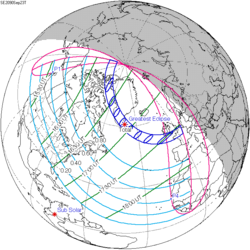| Annular eclipse | |
| Gamma | −0.448 |
|---|---|
| Magnitude | 0.9734 |
| Maximum eclipse | |
| Duration | 171 s (2 min 51 s) |
| Coordinates | 25°42′S175°00′E / 25.7°S 175°E |
| Max. width of band | 106 km (66 mi) |
| Times (UTC) | |
| Greatest eclipse | 23:39:10 |
| References | |
| Saros | 135 (41 of 71) |
| Catalog # (SE5000) | 9624 |
An annular solar eclipse will occur at the Moon's ascending node of orbit between Sunday, September 22 and Monday, September 23, 2052, [1] with a magnitude of 0.9734. A solar eclipse occurs when the Moon passes between Earth and the Sun, thereby totally or partly obscuring the image of the Sun for a viewer on Earth. An annular solar eclipse occurs when the Moon's apparent diameter is smaller than the Sun's, blocking most of the Sun's light and causing the Sun to look like an annulus (ring). An annular eclipse appears as a partial eclipse over a region of the Earth thousands of kilometres wide. Occurring about 5.9 days before apogee (on September 28, 2052, at 20:25 UTC), the Moon's apparent diameter will be smaller. [2]
Contents
- Eclipse details
- Eclipse season
- Related eclipses
- Eclipses in 2052
- Metonic
- Tzolkinex
- Half-Saros
- Tritos
- Solar Saros 135
- Inex
- Triad
- Solar eclipses of 2051–2054
- Saros 135
- Metonic series
- Tritos series
- Inex series
- References
- External links
The path of annularity will be visible from parts of southern Indonesia, East Timor, the northern tip of Queensland, Australia, and New Caledonia. A partial solar eclipse will also be visible for parts of Australia, Indonesia, the Philippines, Oceania, and Antarctica.






































































































